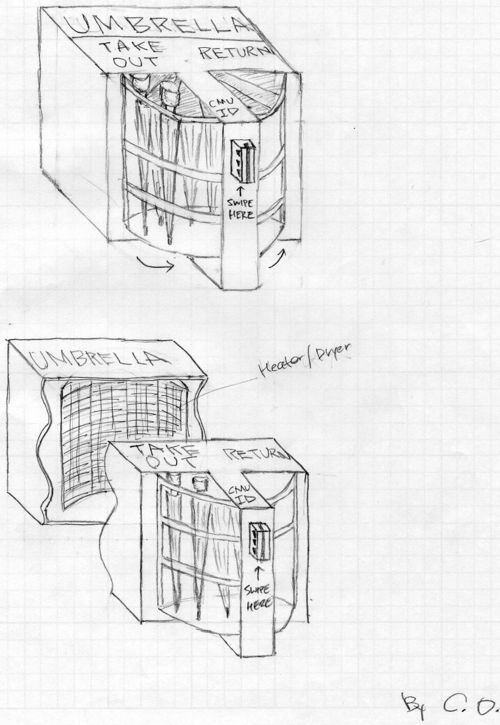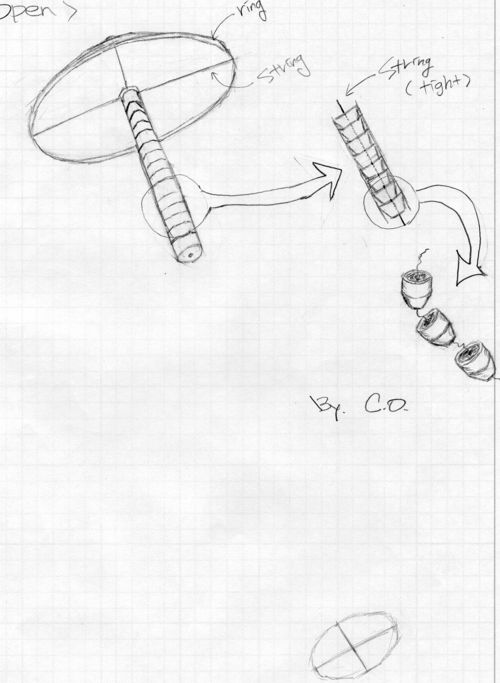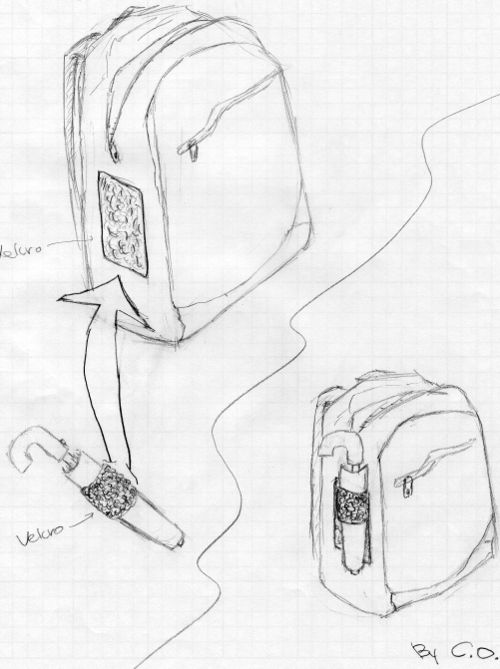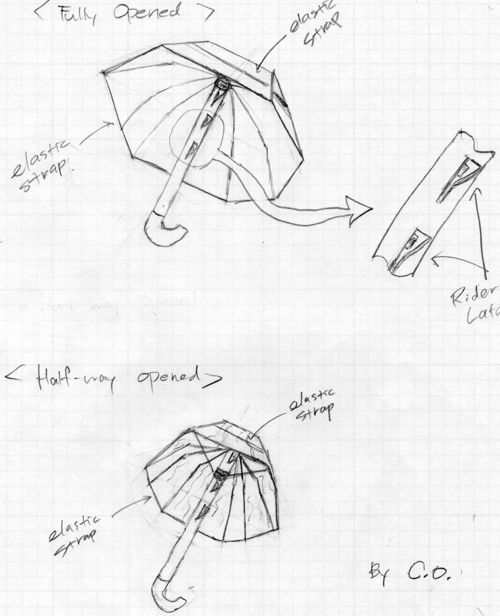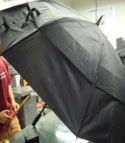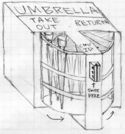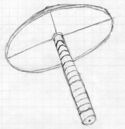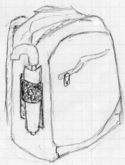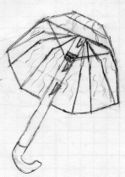Umbrella redesign
From DDL Wiki
Contents |
Executive Summary
For this phase of the project, we analyzed how people view and interact with umbrellas. Alternatives to the current usage and design of umbrellas were developed to better suit the needs identified during our market research. These alternatives were then compared on a Pugh chart and a timeline for completing the project was created using a Gantt chart.
Our market research showed that customers' wants diverged somewhat from what we had predicted. Our anticipation was that customers would place a relatively high value on durability and usability. However, people's largest issue with umbrellas was loss, followed by portability, usability, and coverage. Consumers want to have an umbrella available to them when they need it, and many had significant complaints about losing umbrellas. They tended to go towards one of two groups: one which wants a large umbrella that is difficult to lose, and one which wants to keep many small umbrellas in various locations so that one is always available. People seem to not mind an umbrella which is slightly damaged so long as it does not have significant impact on usability. Also, older people tended to have difficulty closing compact umbrellas, which require dexterity and some amount of force to close.
Four design concepts were generated to deal with these concerns. These designs are:
- An ID checkout system, designed to deal with the issues of loss and portability
- An adjustable ring umbrella, designed to deal with the issue of portability
- A Velcro attachment point for a backpack or back, designed to deal with the issues of loss, portability, and usability
- An adjustable canopy size, designed to deal with the issue of coverage
Our analysis of these designs versus the existing umbrella showed some improvement, but the scores of the chart are too close to clearly identify a single winning redesign concept.
From among our alternatives, we have decided to continue development with our first concept, the ID checkout system.
Research and Observations
Design Problem
On a fundamental level, the purpose of the umbrella is to provide a sense of safety and protection from the elements. Umbrellas keep us dry during the rain, offer mild wind resistance, and even protect us from the sun by providing shade on hot days. Umbrellas have seen many forms and evolutions over their history which have attempted to address these needs. Despite this, there are still trade-offs and constraints, both technological and psychological, which have prevented us from designing an umbrella which completely meets all of our needs. Select examples of these trade-offs include:
- Coverage vs. Weight - People want a large coverage area, but don't want an umbrella that is heavy to hold up or carry around
- Coverage vs. Ease of navigating crowds - People want a large coverage area, but walking through a crowd with a large umbrella is difficult
- Coverage vs. Portability and Storage - People want a large coverage area, but need the umbrella to fold or collapse into a small form factor that can be easily carried
- Ease of Use vs. Portability - The umbrella should be easy to open, but mechanisms that reduce the size of the umbrella decrease the ease by which it can be opened
Current umbrella solutions aim to solve a few of these trade offs, but there is no solution which matches all these needs perfectly.
Our task is to analyze these trade-offs and generate concepts that will be able to better serve the needs of the consumer.
User Studies
Survey Questions
The following information was collected from study participants. The questions were asked and recorded by one of the team members, along with usage observations.
- Demographic information
- What do you do when it rains?
- What do you do once you get out of the rain?
- How much did you pay for your current rain protection device, how long have you had it, and what happened to your previous one?
- What other options have you tried?
- Why did you choose what you currently use, compared to the other options?
- What’s your favorite feature?
- What’s your least favorite feature?
- If you could improve some aspect of the product, what would it be?
- If you could have the perfect rain protection device, what would it be like?
- Please rate the following categories from 1 to 5, with 1 being something that is unimportant to you and 5 being very important:
- Durability
- Aesthetics
- Weight
- Size
- Coverage
- Ease of use
- What about your device is difficult to use?
- Do you have any workarounds for these difficulties?
- The participants then were asked to use the standard umbrella, golf umbrella, purse umbrella, and auto open/close umbrella. Observations were recorded by a team member.
- What did you like and dislike about the sample umbrellas?
- Other remarks or comments?
Observations
From the user studies we have done so far, we have found out that everyone has different preferences about their umbrella usage. The following is the summary of the observations of the different umbrella users.
- Umbrella loss is a big issue
- Auto open close is difficult to close for the elderly
- Jamming umbrella against the wall or getting someone's help to close the umbrella.
- Pushing the umbrella against the user's body using both hands to close it.
- Relatively young users preferred Auto open close umbrella since it is possible to handle it with one hand.
- Purse umbrella was confusing to figure out how to open and difficult to open /close
- Purse umbrella was preferable for someone who wants to an umbrella to be compact and small enough to fit in one's purse or bag.
- Golf Umbrella was too large to carry around even though it has superior coverage to the others.
- Double straps of Golf umbrella were hard to be noticed from the first look.
- It is hard to get into a car with an umbrella opened when it rains.
- Easier and more immediate access to umbrella when necessary.
We have identified that the elders don't usually carry around their own umbrella. They usually have someone else to support them. But if they do, their common issue about the umbrella was difficulty in closing umbrella. Most of the umbrella users have common issue in losing the umbrella even before it stops functioning.
Selected Responses
Among the answers to the survey questions posted above, the following responses are selected.
- "I want the size of my umbrella to be adjustable, so I can get into my car with an umbrella when it rains. In that way, I don't need to get wet when I get in."
- "I don't want to lose my umbrella in any case since I usually lose one and get a new one before it breaks off."
- "I want my umbrella to be smaller, so it's easier to carry around."
Pictures
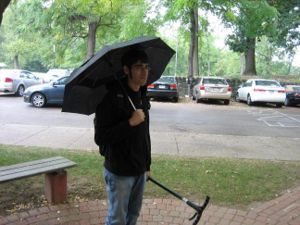
This picture shows how users often rest umbrellas on their shoulders instead of holding them vertical.
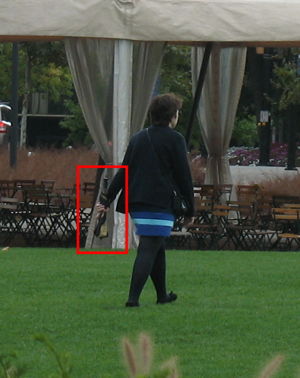
This picture shows how users often carry umbrellas at their center of gravity because it makes it more comfortable to hold.
Current Developments in Umbrella Design
Major Types and Models
This section provides an overview of the major types and styles of umbrellas, along with information about the stakeholder needs they are designed to satisfy.
Compact/Purse Umbrella
Description:
Smaller sized collapsing and expanding umbrellas which are designed to fit inside of purses and briefcases. These umbrella designs typically have more moving parts and therefore are more prone to break and cost more. The complex linkages take dexterity and force to open, making it difficult for some to use a compact umbrella.
A full description of this umbrella can be found in our first report.
Needs satisfied:
- Portability
Golf Umbrella
Description:
The golf umbrella is a full-size umbrella that contains a large spring in the rider mechanism. This spring allows the umbrella to be opened quickly with the push of a button. Additional force must be applied to close the umbrella.
A full description can be found in our first report.
Needs satisfied:
- Ease of use (for some: the umbrella takes additional force to close)
- Coverage
Auto Open/Close
Description:
The auto open/close umbrella uses springs inside the shaft and inside the arm linkages. A press of a button on the handle allows the umbrella to fully extend. A second press collapses the canopy. The shaft must then be manually collapsed to reset the mechanism for use.
A full description can be found in our first report.
Needs satisfied:
- Portability
- Ease of use (for some: considerable force is needed to reset the springs)
Patented Technologies
- Asymmetric umbrella
- Umbrella with interchangeable tops
- Radio equipped umbrella
- Umbrella holster
- Umbrella holder secured to wheelchair
- Detachable cover umbrella
- Fold up umbrella
- Umbrella with two-way flashlight
- Collapsible umbrella with sheathing handle
- In room umbrella dispenser
- Umbrella handle with a hanging loop
- Illuminating umbrella
- Umbrella with radiant heater
- Flashing umbrella
- Telescopic collapsible umbrella frame
- Umbrella with alarming and lighting functions
- Inflatable umbrella
- Umbrella cap hat
- Hands-free umbrella holder
The above patents show many concepts for umbrella modification. None of our ideas should infringe on the above patents, and no other applicable patents were found during our search.
Conclusions
After speaking with several users and looking at how users interact with umbrellas, several interesting conclusions were drawn that may help in our redesign process:
- Getting into a car is difficult with an umbrella - they fold the wrong way
- Umbrellas need to be easier to close - currently people push it against their bodies or against a wall to close them.
- Umbrellas need to be easier to find when you need them
- Losing an umbrella is a larger issue than expected - a lot of people purchased their current umbrella because they had lost their previous one, rather than to replace a non-functioning umbrella
- Some couldn't figure out how to open the purse umbrella, and found it hard to open and close
- Used both hands to push the auto-open/close button, or couldn't find the button easily (older generation)
- Golf umbrella too big and unwieldy
- The portability and compactness was important for people who carried their umbrellas around
- Want large coverage area, but also want the umbrella to be small and compact when carrying
- Liked the fact that you could open the auto-open/close with one hand (younger generation)
- Having the open and close functions located on the same button makes it easy to accidentally close the umbrella prematurely.
Updated Stakeholder Needs
Summarizing our user research, the areas most widely requested by customers can be broken down into 4 main needs:
- Umbrellas should be hard to lose
- Umbrellas should be easy to open and close
- Umbrellas need to be portable
- Umbrellas should provide adequate coverage
As always, cost is also a consumer need, but it was not mentioned often during the user study, most likely because umbrellas tend to be very similarly priced at about $10 for basic style umbrellas and $15-20 for more complex umbrellas.
Our research did not identify any additional stakeholder needs for other groups, such as manufacturers. Our original stakeholder need breakdown can be found in our first report.
We generated new design concepts to satisfy these identified needs. They concepts are discussed in detail in our Design Concepts section
Design Concepts
Concept 1: ID Checkout System
Problem Description
An umbrella is in use for a relatively short amount of time, relative to its overall life: an umbrella will keep you dry on a five-minute trip between buildings, but then sits unused inside a backpack or on the floor. Umbrellas are also carried when it isn't raining, but there is a chance of rain. Many people carry small umbrellas that are more difficult to use, or reduce coverage area, to diminish the inconvenience of carrying an umbrella when it is not in use.
Concept Overview
This concept is a system of communal umbrellas. It could be implemented in a college campus, hospital complex, or any facility with multiple buildings.
The device to achieve this contains three major components: a location to deposit umbrellas, an ID scanner, and a location to receive umbrellas. An ID swipe allows the user to get an umbrella. The umbrella is used while in transit from one building to another. At the second building, the umbrella is deposited at a second device.
This system would work well for people that spend most of their time in a complex of buildings, such as a college or large work complex.
Advantages
- Reduced umbrella number: instead of each individual having an umbrella, a relatively smaller number of umbrellas can serve a community of users
- Standardized umbrellas: umbrellas can be purchased in bulk directly from a single manufacturer, resulting in reduced unit cost compared to retail
- Full-sized umbrellas: the system would most likely use full-sized umbrellas, which are significantly more durable and easier to operate for a wide variety of people compared to compact umbrellas
- Reduced umbrella breakage from storage: umbrellas are in general fairly strong when in use, but umbrellas, and compact umbrellas in particular, are subject to abnormal stresses on the canopy and linkages not accounted for in the design when the umbrella is put into a backpack
- Reduced floor wetness: fewer umbrellas would be carried wet through hallways, resulting in less water on slick tile floors
Disadvantages
- Convenience: the system must be easy to use and not take an excessive amount of time
- Availability: enough devices must be installed, and they must contain enough umbrellas, that a user can reliably expect to be able to receive an umbrella when needed
- Umbrella end-of-life: the device should have some mechanism to identify damaged umbrellas an remove them from circulation
- Sanitation: the umbrellas should be cleaned, specifically the handle and rider, since they are touched by multiple people
- Robustness: the device must be able to withstand moisture from the returned umbrellas
Sketches
Concept 2: Adjustable Ring Umbrella
Problem Description
The standard umbrella suffers from a key deficit with respect to storage: its cylindrical shape in the collapsed position is not well suited to storage in briefcases and bags. This is because these storage items are designed to hold papers and folders with a flat profile and large surface area. When standard umbrellas are introduced into this space they often prevent the storage of full sized papers or cause damage to the papers stored in this space.
Concept Overview
This proposed design features a flexible ring around the perimeter of the canopy which can be folded into a more compact circular shape. This is based on the design of foldable Frisbees.
This allows the umbrella to collapse into a relatively flat shape which is also very flexible, allowing it to fit in a variety of spaces. In order to maintain the compact nature of this umbrella the shaft is comprised of multiple short locking segments. These segments are strung together by two strings which are connected opposite to one another to the outer ring of the umbrella. This feature causes the string to become taught when the umbrella unfolds, pulling the shaft segments together into a complete shaft. Additionally, the umbrella is kept stable by strings connecting the outer ring to the shaft. These will ensure that the canopy remains centered on the shaft during umbrella movement and wind.
A design of this type would fold flat for storage. It would work well for anyone who wants to carry an umbrella with them at all times, but cannot fit a standard umbrella in their bag.
Advantages
- Easy to transport
- Easy to open
- Unique design
- Low part count
- Flexible collapsed shape
- Flexible design improves durability and safety
Disadvantages
- Difficult to close
- Non traditional design
- Complex shaft
- Cannot be used as a cane
Sketches
Concept 3: Velcro Umbrella
Problem Description
Regardless of the type or size of an umbrella, the portability of an umbrella is a fundamental need. This portability is not only a function of the weight and shape of the umbrella, but also relates to how the user holds and interacts with the umbrella. These concerns do not apply just during operation in the rain, but also when the user is walking inside or during non-raining periods. Portability is such an important issue that users are willing to sacrifice critical features like coverage in order to make an umbrella easier to handle. The development of the purse umbrella is a distinct embodiment of this line of thinking.
Another major issue exists in umbrella storage after operation. In this case a partially wet umbrella must either be carried by hand or placed in a bag or backpack. Either one of these current solutions is sub-optimal. In the first case, the user has to hold onto the umbrella by hand, limiting the user's mobility and forcing them to carry the umbrella. In the second case, the user is forced to place a wet umbrella into their backpack or purse, potentially damaging other objects that the umbrella comes into contact with.
Concept Overview
The Velcro Umbrella seeks to alleviate this problem by allowing the user a hands-free way of transporting an umbrella, post use. The basis of the concept lies in transforming the standard umbrella strap, currently used to wrap the umbrella, into a velcro interface for increased portability and ease of use. The umbrella strap, which would feature the male side of a velcro strip, would be partnered with a matching female velcro strip that could be attached to the outside of a backpack or jacket. In this way the umbrella can be easily attached and removed to a backpack, enabling the user to use his or her hands, but without the disadvantage of having to store the umbrella on the inside of a bag.
This would be most useful for people that carry an umbrella as well as a backpack or briefcase, and for those that spend a good deal of time moving around inside a building after coming in.
Advantages
- Easy and visual storage mechanism for umbrella when not in use
- Fast access to the umbrella - No need to dig through a bag
- Can attach an umbrella to anything that can have a velcro patch sewed to it
- Minimal redesign to existing umbrellas
- Can fit any umbrella design
- Low implementation cost
Disadvantages
- Easier to steal
- Possibility of loss if incorrectly attached
- Female velcro side can degrade over time
- Male velcro is not the most ergonomic material to hold on to when grabbing/holding umbrella
Sketches
Concept 4: Adjustable Shape Umbrella
Problem Description
To ensure adequate coverage for a variety of wind conditions, umbrella canopies are larger than the people that the umbrella shelters. This becomes an issue in crowded areas, such as sidewalks, because sidewalks are sized to accommodate a given volume of foot traffic but generally are not sized to accommodate each person having an oversize umbrella. As a result, umbrella usage increases congestion on sidewalks during rainy days, at the same time that sidewalks are most needed as rain turns grass to mud.
Concept Overview
This concept is an umbrella that can reduce its canopy size while in use.
The standard umbrella has two locking position for the rider: up and down. These positions correspond to the umbrella being fully open or fully closed. Additional locked rider positions allow the canopy to maintain a partially open position. Also, elastic bands are used around the circumference of the canopy to reduce the slack in the canopy when the umbrella is partially open.
This concept would be well suited to people who regularly travel through crowded areas with umbrellas, for example in cities or on college campuses.
Advantages
- Reduced sidewalk congestion: this is an advantage for both people that do and do not use umbrellas in the rain
- Better maneuverability: allows the umbrella users to enter doorways and other tight passages
- Few additional parts: relatively inexpensive and easy to implement and use, since it modifies an existing part
Disadvantages
- Canopy slack: a canopy is designed to be taut when the umbrella is fully open, and excessive slack will catch gusts of wind and flutter or pop, stressing the connection between the canopy and arms - this can be reduced with elastic
- Durability: the shaft may be weakened by the additional components, depending on implementation
- Aesthetics: a half-open umbrella looks broken, regardless of functionality
Sketches
Concept Evaluation
Pugh Chart
From this grading, the Velcro bag storage has the highest composite score, with the other concepts very close together. By itself, however, the addition of the Velcro strap would be very simple, and would be better as part of a larger composite concept incorporating other improvements as well. The close spacing of the other concepts shows that there is not one idea that stands out from the rest.
Recommendations
So far, we have come up with four different ideas to fulfill the four major customer needs identified from the user studies conducted. Adjustable ring umbrella concept has decent mechanical system to operate but it was rated unpractical in everyday use because of the complexity of the opening/closing action, even though this idea can satisfy one of the customer needs related to the portability. Adjustable size umbrella design scored same points from the Pugh chart as the Adjustable ring umbrella did, although the concept fits into the customer need regarding the canopy coverage. For the prototype of new umbrella design, ID takeout deposit system concept would be preferable even though customizable bag storage concept obtained highest net score from the Pugh Chart posted above. This is because the velcro umbrella lacks the necessary movable mechanical system in the concept, which is required by the objective of this project. The ID takeout deposit system has gained the second highest score in grading of Pugh Chart, and still satisfies the customer needs of umbrella loss and portability issue. However, we still need to come up with ideas to make the system more operable in more efficient ways and prevent possible umbrella theft issue.
Development Timeline
Our team has broken up the remainder of the semester along three main tasks: the creation of design prototypes, the creation of a production CAD model and the execution of component analysis in order to develop the design. After receiving feedback from this report we will meet to discuss design improvements and finalize our design. After a final design is decided on Changho Oh will develop detailed design sketches with the help of the team. After these sketches are completed Ben Berkowitz will developing a mockup of our design in order to test user interactions with it and Mark Fuge and Michael Cushman will develop a CAD model of our design using SolidWorks.
After these models are presented at Design Review 1 we will reconvene to discuss feedback and potential design improvements. Based on these improvements Changho Oh and Mark Fuge will perform finite element analysis on design components in order to verify and optimize their function. During this process Michael Cushman will update and refine the CAD model to represent our planned production design. While the production CAD model is being developed Ben Berkowitz will create a functional prototype of our refined design in order to test its function and use. Additionally, before Design Review 2 this new prototype will undergo user testing in order to evaluate its performance and to uncover potential improvements.
After these improved models and designs are presented at Design Review 2 we will once more reconvene to discuss design feedback, develop improvements and to settle on the final design. After the final design is settled on Changho Oh will finalize component design using finite element analysis and Michael Cushman will update the CAD Model to represent a finalized, production ready product. Based on the final concept Mark Fuge will develop DFMA, DFE and FMEA reports in order to represent the production design and impact of our product. During this period Ben Berkowitz will fabricate our final design prototype and perform user testing of this design. After these tasks are completed we will draft a provisional patent for our design and as a team complete our poster representing our product design.
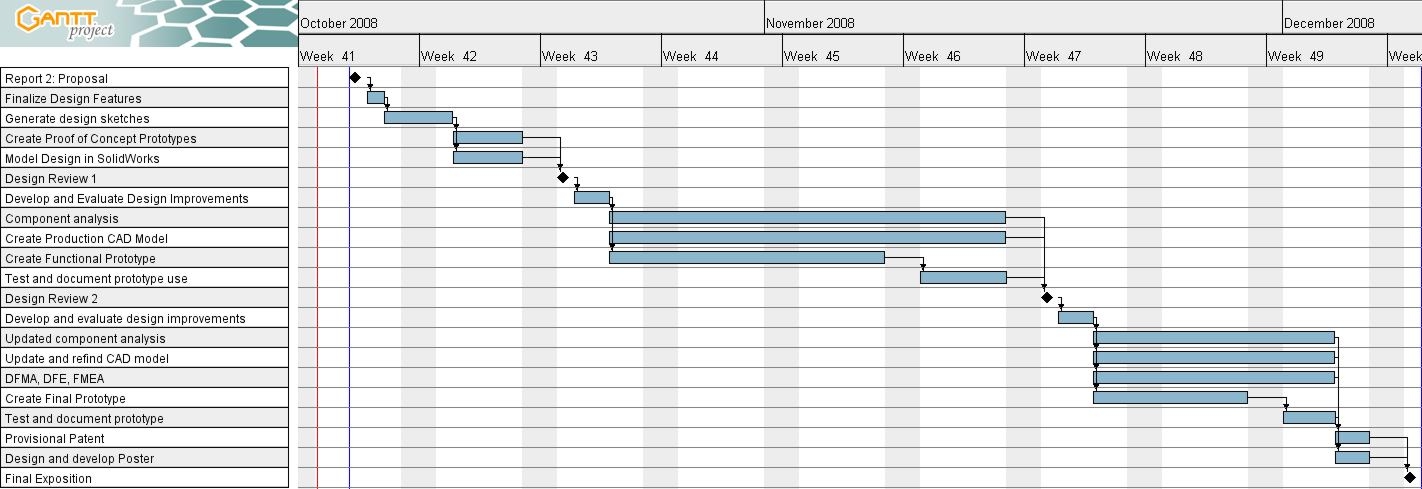
Team Member Roles
Ben Berkowitz - Collapsible Ring umbrella description, Pugh Chart, Gantt Chart
Michael Cushman - ID takeout concept description, Adjustable shape umbrella concept description, Executive summary, Relevant patent listing, Updated stakeholder needs
Mark Fuge - Velcro umbrella concept description,Design problem, Conclusions
Changho Oh - Sketches, Relevant patent listing, Recommendations
All - User studies, Design concepts
Appendix
List of Design Concepts
- Tracking device
- Alarm system
- Distribution system
- Distress beacon
- Auto close and lock theft protection
- Forgetting beeper based on distance away from it
- Walk and follow you
- Autonomous helicopter following
- Belt holster
- Umbrella holster storage
- Reallllllllllllllly big (unreasonably)
- Tether
- Beeps
- Glow in the dark
- Vibrating
- Clapper - moved to you when you clap
- Bright color
- GPS tracking
- Dock
- Holster
- Backpack holder
- Contact info holder
- Cheap enough to buy many
- Disposable - one time use
- Rental
- Deposit system
- Umbrellas everywhere/communal umbrella
- Student ID takeout
- Single user/authorized user umbrella
- Anti-theft
- Heavy
- Expensive
- Customizable
- RFID distance vibrator
- WiFi Location transmitting umbrella
- Magnetic/sticky umbrella
- Umbrella incentive program
- iBrella - cellphone
- Complete closing
- Inflatable
- Motorized canopy
- Memory foam handle
- Memory fabric umbrella aka batman
- Folding instead of collapsing
- Gyroscopically stabilizing
- Motorized
- Water sensitive
- voice commanded
- Clapper
- Snapper
- Floating
- Ring umbrella - collapsing
- Pulsing riser
- instructions on handle
- Pull string
- Handle/crank
- Life raft - compressed air
- Counterweight
- Kinetic energy umbrella
- Energy creating umbrella through motion
- Magnetic riser via rail gun
- Wind opening
- Pinwheel energy creating
- Solar umbrella
- Darkness powered
- Eddy currents
- Umbrella helmet
- Adjustable shaft height - like painting rods
- Scroll wheel opening/closing
- Glove attached umbrella
- Glove to carry wet umbrella
- Counterweight to balance while carrying
- Sliding handle to hold umbrella closed and make easier to carry
- Fold over
- Inside-Out
- Inflate with gas
- Flips inside out
- Zipper
- Umbrella sheath
- Lease/clip
- Special storage in bags/shorts/etc.
- Velcro umbrella
- Magnetic
- Incorporate into clothing
- Wheel in tip of umbrella
- Multi-function umbrella - attachable tray
- Higher fold ratio
- Modular
- Purse, Purse umbrella
- Unreasonably small
- Magic school bus umbrella
- Spongy dinobrella
- Relativistic umbrella
- Umbrella plant
- Full body umbrella
- Adjustable canopy profile (less or more curvey)
- City sized
- Shape changing, streamline
- Joins up with other umbrellas to form super umbrella
- Merge with girlfriends umbrella
- Bigger!
- Configurable canopy
- Adjustable joints
- Stretchy umbrella
- Bodybrella
- Adjustable angle shaft
- Awnings everywhere
- Shockwave
- Automatically expanding - vibration sensor
- Pogobrella
- Automatically expanding - accelerometer
- Umbrella colony - merging umbrellas
- Scented umbrella
- Leaved umbrella
- Customizable Velcro umbrella
- Rape whistle
- Flashlight umbrella
- Closes inversely/ opposite regular
- Music playing/ reflected by canopy
- Built in cell phone/bluetooth umbrella
- Cell phone charging umbrella
- Modular umbrella,replace/upgrade components
- Heated drying umbrella
- Spinning drying umbrella
- Soft tips so you don't poke people
- Hand warmer
- Space heater
- Inward folding to trap water
- Grabber/ robo claws
- Opacity changing
- Solar cell
- Display/ blackberry monitor
- Advertising
- External message display
- Built in mirror
- Built in makeup, lipstick, etc
- iPod dock
- Bike lock
- Bike pump
- Tire gauge
- Satellite receiver/ antenna
- Walkie-talkies
- LED flashing/ spinning text
- Wifi detector
- Key/ wireless keys umbrella
- Leash attachment
- Dog whistle
- Cup holder/ straw
- Lights
- Pressure sensitive handle-speed of opening,shape, volume control
- Hand exercise
- Stress ball handle
